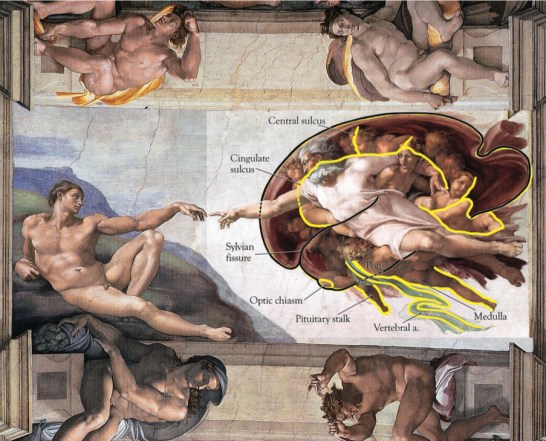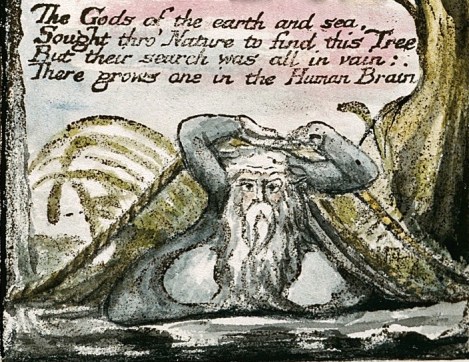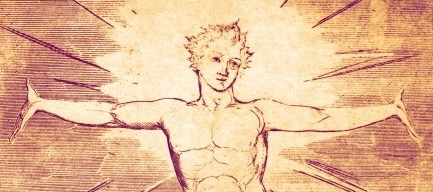
When asked where his inspiration came from, Blake is said to have pointed to his forehead and replied, “Here, madam.” Blake was certainly one of the most physically aware and grounded of all artists and poets: his poems, like his etchings and illustrations, are filled with sinews, bodies, muscles, fibres, nerves, veins, and globules. But surprisingly few readers or literary critics have taken the hint—that Blake’s visions and experiences belonged to and occur within the structure of the human brain and body itself.
In an extraordinary passage at the start of his poem Milton, for instance, he invokes the sources of poetic inspiration and asks for their support in his poetic endeavour. Of course, this is often a traditional conceit, usually addressed to ephemeral “Muses”. What is striking about Blake’s address is that he locates the origin of his inspiration within the structure of his own brain, not from any source outside it. “Come into my hand”, he urges it, “By your mild power; descending down the Nerves of my right arm/From out the Portals of my Brain” (Mil, 2:5–7). Indeed, Blake consistently and emphatically locates his experiences— the figures, characters, forces and powers—within the actual physical human body.
One of the main themes of Blake’s work concerns the emergence of a Power within the human psyche which he calls the “Reasoning Power” or, more usually, simply “Urizen” (‘your reason’). As Urizen himself proclaims: “I am God O Sons of Men! I am your Rational Power!” (Jer 54:16). Urizen is repeatedly associated by Blake with the human brain, and indeed that is where he is located. Los, who shares this location with him, specifically describes Urizen’s world as being within “the Brain of Man”:
I see the swords & spears of futurityTho in the Brain of Man we live, & in his circling Nerves.Tho’ this bright world of all our joy is in the Human Brain.Where Urizen & all his Hosts hang their immortal lamps(FZ 11:14–17)
My thesis is that for us as human beings there are two fundamentally opposed realities, two different modes of experience; that each is of ultimate importance in bringing about the recognisably human world; and that their difference is rooted in the bihemispheric structure of the brain. It follows that the hemispheres need to co-operate, but I believe they are in fact involved in a sort of power struggle, and that this explains many aspects of contemporary Western culture.The difference, I shall argue, is not in the ‘what’ [each hemisphere does], but in the ‘how’ – ‘the manner in which’, something no one ever asked a machine. I am not interested purely in ‘functions’ but in ways of being, something only living things can have. (McGilchrist, The Master and his Emissary).

As McGilchrist observes, it is the right hemisphere of the brain that delivers not only our understanding of metaphor (the left brain is forever trapped within the merely literal) but also our apprehension of transcendence. “The ‘lived’ body, the spiritual sense, and the experience of emotional resonance and aesthetic appreciation are all principally right-hemisphere-mediated.” These two distinct modes of apprehension or ways of knowing the world – the imaginative and the rationalising – were highlighted by Blake two hundred years ago: “He who sees the Infinite in all things sees God. He who sees the Ratio only sees himself only” (NNR). Interestingly, McGilchrist cites this passage from Blake in order to illustrate hemispheric difference, providing a useful neuroscientific interpretation of it in brackets: “He who sees the Infinite [looks outward to the ever-becoming with the right hemisphere] in all things sees God. He who sees the Ratio only [looks at the self-defined world brought into being by the left hemisphere] sees himself only [the left hemisphere is self-reflexive].”
Blake’s figure of Jesus is central to this process, both in integrating and mediating the “spiritual sense” – the right-hemisphere mode of seeing – and also in incarnating the ‘lived’ body, the embodiment of right hemisphere values and approaches into human history itself, through the alignment and integration of divinity and humanity. As McGilchrist himself observes:
The Western Church has, in my view, been active in undermining itself. The 2,000-year old Western tradition, that of Christianity, provides, whether one believes in it or not, an exceptionally rich mythos for understanding the world and our relationship with it. It conceives a divine Other that is not indifferent or alien – like James Joyce’s God, refined out of existence and ‘paring his fingernails’ – but on the contrary engaged, vulnerable because of that engagement, and like the right hemisphere rather than the left.
At the centre of this mythos are the images of incarnation, the coming together of matter and spirit, and of resurrection, the redemption of that relationship, as well as of a God that submits to suffer for that process.
